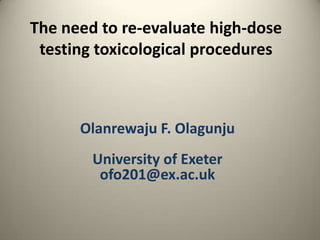
The Need To Re-evaluate High Dose Testing Toxicological Procedures[1]
- 1. The need to re-evaluate high-dose testing toxicological procedures Olanrewaju F. Olagunju University of Exeter ofo201@ex.ac.uk
- 2. Outline: Introduction The basis for the present toxicological methods Why NOEC and LOEC may not always be reliable The non-linearity of high-dose testing Other sources error Recommendation
- 3. Who said this? All substances are poisons; there is none which is not a poison. The right dose differentiates a poison from a remedy. Paracelsus, 1567 ? www.freedigitalphotos.net
- 4. “the dose makes the poison” This observation by Paracelsus gave rise to the approach of using very high-dose testing to predict consequences of much lower doses that are typically within the range of widespread human exposure, which toxicologists paraphrase as “the dose makes the poison”; This have served as the basis of estimating NOEC and LOEC in ecotoxicological studies. Myers et al. 1995
- 5. Ecotoxicology(ECT):From laboratory to regulatory Experimental analysis of chemical toxicity thus serves as an area where science interacts strongly with public safety through science-informed policy making (Forbes and Forbes 1994). Given this critical role of toxicology, it is important that the methods and procedures involved be clearly understood and well scrutinized.
- 8. The procedure and its weakness These levels, NOEC etc. are established by the hypothesis testing approach, which in turn usually mean analysis of variance; The hypothesis often tested H0 = no difference (i.e. not harmful) H1 = there is difference (i.e. harmful) Using 5, 11, 20 and 50 replicates, he tested these hypotheses Laskowski 1995.
- 9. The probability of rejecting the null hypothesis at a particular number of replicate. Laskowski 1995.
- 10. What does this mean? It means that the chance of accepting the null hypothesis (no effect) is as high as 39%; It means there is 39% chance of taking this level as NOEC; It means that the substance for which we are assuming no effect has 39% chance of harming; Using 0.05 level of significance Laskowski 1995.
- 11. Question Who will consume a product that has 39% chance of being toxic; Or even take a drink that is labelled “2% poison”? Hence, Taking NOEC from that level may mean a similar level of risk. Poison: 2%
- 12. Assumption of dose-response linearity Review of the toxicological concept The higher the dose the higher the effect Effect reduces with dose till there is no more observable effect (NOEC) Toxicity measurement thus starts from a very high toxic dose to where little and/or no effect is observed (LOEC and NOEC) This assumes a linear relationship, which is not always true.
- 13. Some pollutants have been shown not to follow the linear dose-response curve assumption of high-dose testing e.g. Hormonally active substances. Rather their effect is non-monotonic; i.e. It can either decrease or increase with increase in dose. For example the carcinogenic effect of Bisphenol A (BPA). Non-monotonic effect Myers et al., 2009
- 14. BPA induces cell proliferation in androgen-independent LNCaP prostate cancer cells. (Myers et al., 2009) The response to 100 nM BPA did not differ from control. A standard toxicity test, working down the dose–response curve from high doses, would have shown no difference between controls and exposed animals at a dose at that level or above and would have used it to identify the “apparent no observed adverse effect level (NOAEL),” indicated by the arrow (Myers et al., 2009)
- 15. Other methodological errors Errors involved in the use and reporting of concentration Nominal concentration: Quantifiable amount added– little ecotoxicological relevance; Measured concentration: Concentration in the medium– more ecotoxicologically relevant; Dose: Defined by the actual amount of the chemical substance that could interact with the living system– which highly depends on the chemical’s bioavailability. Forbes and Forbes, 1994.
- 16. Where the risk lies Incomplete estimation of effect: Degeneration without proliferation; Underestimation of effect: Only effective at a very high dosage; Wrong assumption: No effect at all– type II error FALSE ASSURANCE
- 17. Points for scientific consideration Using statistically relevant number of replicates (eleven and above)1; Use of other reliable statistical tool such as the regression analysis tool1; Toxicity measurement from very low concentration2; Measuring in terms of dose bioavailability and avoiding, where practicable, use of nominal concentration3. Laskowski 1995. Myers et al., 2009. Forbes and Forbes, 1994.
- 18. Conclusion In order for science to be able to provide reliable and policy-relevant safety information: there is need for re-evaluation of these procedures; adoption of non-monotonic concept of hormonally active substances in toxicological procedures and reviewing of past standards; use of wide dose range in ecotoxicological assessments.
- 19. Then... GUARANTEED 100% www.freedigitalphotos.net Thank you!
- 20. References Forbes, V.E. and Forbes, T.L. (1994). Ecotoxicology in theory and practice. Chapman and Hall, 2-6 Boundary Row, London SE1 8HN, UK. Laskowski, R. (1995). Some Good Reasons to Ban the Use of NOEC, LOEC and Related Concepts in Ecotoxicology.Oikos, Vol. 73, No. 1, pp. 140-144. Myers,J.P. Zoeller, R.T., and vomSaal, F.S. (2009).A Clash of Old and New Scientific Concepts in Toxicity, with Important Implications for Public Health. Environmental Health Perspective. Vol. 117, No. 11, pp 1652-1655. Presentation title: The need to re-evaluate high-dose testing toxicological procedures
- 22. High-dose test inapplicability Welshons, W.V. et al (2003). Large Effects from Small Exposures. I. Mechanisms for Endocrine-Disrupting Chemicals with Estrogenic Activity. Environmental Health Perspectives. Vol. 111, No. 8, pp. 994-1006.
Editor's Notes
- In regression analysis, the violations and inaccuracies will affect mainly the confidence intervals, but the parameter estimates will be affected to a much lesser extent.
